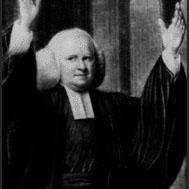 The 18th century brought a series of religious revivals to the American colonies. Preachers traveled through Congregationalist, Presbyterian, Baptist, and Anglican communities, speaking to large crowds, urging renewed piety and personal conversions, and infusing American Protestantism with a lasting individualistic spirit.
The 18th century brought a series of religious revivals to the American colonies. Preachers traveled through Congregationalist, Presbyterian, Baptist, and Anglican communities, speaking to large crowds, urging renewed piety and personal conversions, and infusing American Protestantism with a lasting individualistic spirit.
Although English Christian settlers initially built colonies in isolation from one another, by the early 18th century they increasingly shared a range of experiences: they were Protestant and British; they had rivalries with the Spanish and French; they lived on the frontier of the British empire; and they shared the increasing prosperity of the expanding Atlantic economy.
The colonies had also experienced a history of religious competition and decline, as churches struggled to maintain Christian community in a climate that seemed increasingly marked by religious indifference, economic ambition, and a spirit of compromise. In New England, for example, cycles of waxing and waning piety threatened the mission of the Christian society that Puritans envisioned. In response, ministers often preached “jeremiads,” sermons in the dire tone of the prophet Jeremiah, that chastised colonists and called them back to “true” piety.
In the 1730s and 1740s, a series of local revivals in both Britain and its colonies were fanned into a transatlantic, intercolonial religious movement called the Great Awakening. Preachers like the Massachusetts Congregationalist Jonathan Edwards (1703-1758), the English Anglican George Whitefield (1714-1770), and the Pennsylvania Presbyterian Gilbert Tennant (1703-1764) preached a stirring call to personal conversion, exhorting listeners to seek a “new birth” in Christ. This message had broad appeal. Some championed the revivals as a rejuvenation of existing hierarchies and institutions, while others–especially women, African Americans, and Native Americans–seized upon their own profound religious experiences as an opportunity to exercise spiritual authority.
With its passionate itinerant preachers and testimonies of spiritual transformation, the Awakening helped revitalize and reshape the colonial religious heritage. It also generated religious controversy, as conflict over the nature of “true religion” divided many communities. Many celebrated the deepened piety, but recoiled at the bodily and emotional outbursts that often accompanied revival. Religious establishments in New England and the South reaped a surge in religious interest, but they also lost a torrent of members to energetic upstarts such as Baptists and later Methodists. Clergy enjoyed a renewed position of cultural prominence, but now had to contend with a laity that was empowered to voice opinions and choose the church that best suited them.
The Awakening thus played an important role in fostering a set of individualistic and populist ideals in revivalist religion, ideals that would subsequently come to define “evangelical” Protestantism in America. This new pietism was interdenominational in the sense that its spirit infused Congregationalists, Presbyterians, Baptists, and Anglicans alike. The intercolonial dimension of the Awakening also played an important political role, as it led people up and down the Atlantic seacoast to consider themselves as a single emotional community. This sense of a common American identity proved crucial to the growth of the spirit of revolution when tensions with Britain increased later in the century.